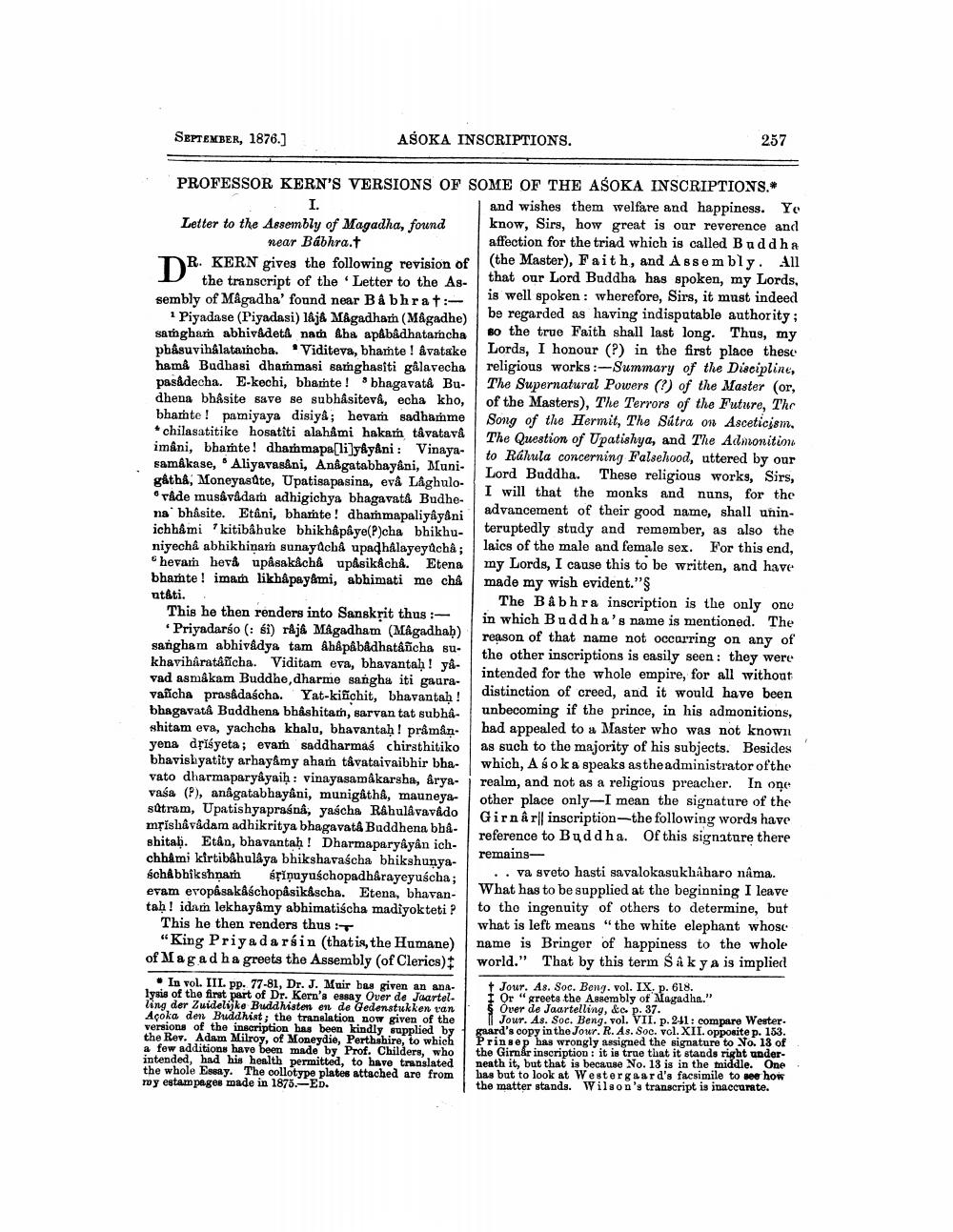________________
SEPTEMBER, 1876.]
ASOKA INSCRIPTIONS.
PROFESSOR KERN'S VERSIONS OF SOME OF THE ASOKA INSCRIPTIONS.*
I.
and wishes them welfare and happiness. Ye know, Sirs, how great is our reverence and affection for the triad which is called Buddha (the Master), Faith, and Assembly. All that our Lord Buddha has spoken, my Lords, is well spoken: wherefore, Sirs, it must indeed. be regarded as having indisputable authority; so the true Faith shall last long. Thus, my Lords, I honour (?) in the first place these religious works:-Summary of the Discipline, The Supernatural Powers (?) of the Master (or, of the Masters), The Terrors of the Future, The Song of the Hermit, The Sútra on Asceticism. The Question of Upatishya, and The Admonition to Rahula concerning Falsehood, uttered by our Lord Buddha. These religious works, Sirs, I will that the monks and nuns, for the advancement of their good name, shall uninteruptedly study and remember, as also the laics of the male and female sex. For this end, my Lords, I cause this to be written, and have made my wish evident."§
The Bâbhra inscription is the only one in which Buddha's name is mentioned. The reason of that name not occurring on any of the other inscriptions is easily seen: they were intended for the whole empire, for all without distinction of creed, and it would have been unbecoming if the prince, in his admonitions, had appealed to a Master who was not known as such to the majority of his subjects. Besides which, A sok a speaks as the administrator of the realm, and not as a religious preacher. In one other place only-I mean the signature of the Girnar inscription-the following words have reference to Buddha. Of this signature there
remains
Letter to the Assembly of Magadha, found near Babhra.t
DR. R. KERN gives the following revision of the transcript of the Letter to the Assembly of Magadha' found near B â bhrat:1 Piyadase (Piyadasi) laja Magadham (Magadhe) samgham abhivâdeta nam &ha apâbâdhatamcha phâsuvihalataicha. Viditeva, bhamte! âvatake hama Budhasi dhammasi samghasiti gâlavecha pasádecha. E-kechi, bhamte! bhagavata Budhena bhâsite save se subhâsitevâ, echa kho, bhamte pamiyaya disiyâ; hevam sadhamme chilasatitike hosatiti alahâmi hakam tâvatavâ imâni, bhamte! dhammapa[li]yâyâni: Vinayasamâkase, Aliyavasâni, Anâgatabhayâni, Munigấtha, Moneyasute, Upatisapasina, eva Lôghulo våde musâvâdam adhigichya bhagavatâ Budhena bhâsite. Etâni, bhamte! dhammapaliyâyâni ichhâmi 'kitibâhuke bhikhâpâye(P)cha bhikhuniyechâ abhikhinam sunayacha upadhalayeyûchâ; hevam hev upâsakâchâ upåsikâchâ. Etena bhamte! imam likhâpayami, abhimati me châ
utâti.
This he then renders into Sanskrit thus:
Priyadarso (: si) raja Magadham (Magadhaḥ) sangham abhivâdya tam âhâpâbâdhatâñcha sukhavihâratâñcha. Viditam eva, bhavantaḥ! yâvad asmakam Buddhe, dharme sangha iti gauravancha prasadaścha. Yat-kiñichit, bhavantaḥ! bhagavatâ Buddhena bhâshitam, sarvan tat subhâshitam eva, yachcha khalu, bhavantaḥ! prâmânyena driśyeta; evam saddharmas chirsthitiko bhavishyatity arhayâmy aham tâvataivaibhir bhavato dharmaparyayaiḥ: vinayasamâkarsha, âryavasa (P), anâgatabhayâni, munigâthâ, mauneyasutram, Upatishyapraśnê, yascha R&hulivavido mrishâvâdam adhikritya bhagavatâ Buddhena bhâshital. Etân, bhavantaḥ! Dharmaparyâyân ichchhami kirtibâhulâya bhikshavaścha bhikshunyaschabhikshnam sripuyuśchopadhârayeyuścha; evam evopasakâschopâsikâscha. Etena, bhavantaḥ! idam lekhayâmy abhimatiścha madiyokteti ? This he then renders thus:
"King Priyadarsin (that is, the Humane) of Magadha greets the Assembly (of Clerics)
257
In vol. III. pp. 77-81, Dr. J. Muir bas given an analysis of the first part of Dr. Kern's essay Over de Jaartelling der Zuidelijke Buddhisten en de Gedenstukken van Açoka den Buddhist; the translation now given of the versions of the inscription has been kindly supplied by the Rev. Adam Milroy, of Moneydie, Perthshire, to which a few additions have been made by Prof. Childers, who intended, had his health permitted, to have translated the whole Essay. The collotype plates attached are from my estampages made in 1875.-ED.
va sveto hasti savalokasukhaharo nama. What has to be supplied at the beginning I leave to the ingenuity of others to determine, but what is left means "the white elephant whose name is Bringer of happiness to the whole world." That by this term Śâ k y a is implied
t Jour. As. Soc. Beng. vol. IX. p. 618.
Or "greets the Assembly of Magadha." Over de Jaartelling, &c. p. 37.
Jour. As. Soc. Beng. vol. VII. p. 241: compare Wester. gaard's copy in the Jour. R. As. Soc. vol. XII. opposite p. 153. Prinsep has wrongly assigned the signature to No. 13 of the Girnar inscription: it is true that it stands right underneath it, but that is because No. 13 is in the middle. One has but to look at Westergaard's facsimile to see how the matter stands. Wilson's transcript is inaccurate.




